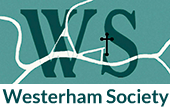Around 1910 there were at least five forges in the town. Verrall and Son were the largest, at today’s Verralls Corner, but Nicholas and Sons ran a busy forge in today’s Burgess’ yard opposite New Street. There was a forge behind the Pheasantry, a forge next to Darenth Nursery at the bottom of Vicarage Hill and Edward Evenden ran one at his ‘West Kent’ works at the bottom of Hosey Hill. The term ‘blacksmith’ is used to describe someone working with dull and dark ferrous metals such as iron or steel. A ‘whitesmith’ was someone who worked with bright metals such a tin and brass. The blacksmiths served the wheelwrights and coachbuilders around the town, fabricated and maintained agricultural implements and machinery for the surrounding farms and most of them shod horses as well.
Chris Pickett re-collected childhood memories “…there were a number of interesting things at the west end of town, such as the two Blacksmiths Forges, Mr. Nicholas’s opposite the Royal Standard Pub near New Street, and Mr. Verrall at Verralls Corner. I remember how fascinated I was to watch them shoeing horses, and working red hot metal on their anvils. While on the subject of Blacksmiths, I must mention the one at the works at the bottom of Hosey Hill, worked by Mr. Chapman for Mr. Evenden. He would mend our broken iron hoops (only on Saturday mornings) for a penny and put new runners on our sledges in the winter! Going back to the west end of town was the coach-builders, next to the Warde Arms, run by two brothers by the name of Woods, very clever men they were, making wooden wheels for big carts and wagons that would be fitted with iron ‘tyres’ by the local blacksmiths, and repairing all kinds of vehicles, mostly horse-drawn…”
George Wells also had fond memories of the blacksmith’s forges of Verrall by Mill Lane and the Nicholas’ Brothers in their yard in the High Street. “…we used to go into Mr. Nicholas’ yard and have a look at what they were doing – he didn’t mind, he used to talk to us, explaining what he was doing and it was nice. I remember Mr. Verrall down the bottom used to have the big old horses in the yard and it was busy there… Verrall carried on into the 1950s, but Nicholas packed it up earlier and Mr. Burgess took the yard over…”
Hubert Verrall did indeed run the forge until 1950 when he retired and sold the business to James Williams.







No Comments
Add a comment about this page